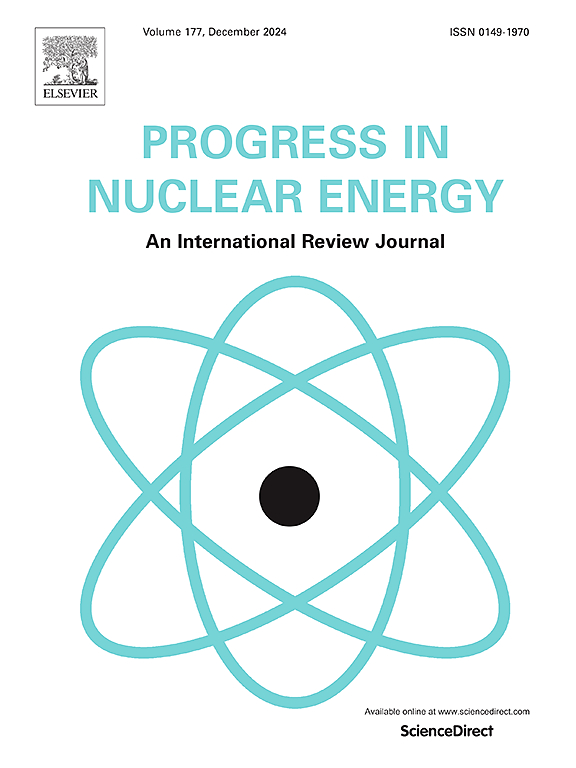四回路压水堆高燃耗堆芯设计与全堆芯燃料性能评估
IF 3.3
3区 工程技术
Q1 NUCLEAR SCIENCE & TECHNOLOGY
引用次数: 0
摘要
提高当前轻水反应堆(LWRs)的燃料排放燃耗有望减少燃料循环和/或运营成本。通过假设一个恒定的核心功率密度,经济收益是由更好的燃料利用率和/或增加的容量系数。为了研究110+ kW/l堆芯功率密度下超过62 MWd/kgU的最大棒平均燃燃,为标准的17x17,193个燃料组件压水堆(PWR)开发了两种堆芯设计。采用平准化单位成本方法来评估燃料循环、运行和维护以及资本成本影响,并检查这两个核心设计途径的经济可行性。核心设计和优化使用商业STUDSVIK代码包执行。燃料性能分析通过审核FRAPCON4.1、FAST1.2和高保真代码BISON在全核心配置中实现。为了提供一个现实的评估,堆芯设计过程考虑了当前压水堆堆芯设计的最佳实践。它在最大允许峰值和硼浓度的各种芯设计约束方面具有可接受的性能。钆(Gd2O3)作为可燃毒物使用,在3批加注方案中,当加注89或77个燃料组件时,其浓度最高可达9 wt%。完整的核心燃料性能模拟,允许表征相关的燃料温度,充气压力,应力和应变,执行相对于两个边界燃耗水平。对于18个月的高燃耗岩心(峰值引脚为68 MWd/kgU)来说,这样的性能可能获得许可,而对于24个月的高燃耗岩心设计途径(峰值引脚为75 MWd/kgU)来说,这更具挑战性。最大杆腔压力被确定为最具限制性的燃油性能参数。虽然目前的研究范围主要集中在稳态和超功率条件下,但新排放燃耗的可接受性必须进一步评估,考虑未来事故情景下的不确定性和影响。本文章由计算机程序翻译,如有差异,请以英文原文为准。
Design and full core fuel performance assessment of high burnup cores for 4-loop PWRs
Increasing the fuel discharge burnup of current light water reactors (LWRs) promises reductions in fuel cycle and/or operations costs. By assuming a constant core power density, the economic gain is enabled by better fuel utilization and/or an increased capacity factor. In this effort to investigate greater than 62 MWd/kgU maximum rod average burnup for 110+ kW/l core power density, two core designs have been developed for a standard 17x17, 193 fuel assemblies pressurized water reactor (PWR). The levelized unit cost methodology is employed to evaluate fuel cycle, operation and maintenance, and capital cost impacts and to examine the economic viability of both core design pathways. Core design and optimization are performed using the commercial STUDSVIK code package. Fuel performance analysis is realized in full core configuration via auditing FRAPCON4.1, FAST1.2, and the high-fidelity code BISON. To provide a realistic assessment, the core design process takes into consideration best practices in current PWR core design. It features acceptable performance in terms of various core design constraints on maximum allowable peaking and boron concentration. Gadolinia (Gd2O3) is used as a burnable poison with a maximum of 9 wt% concentration while feeding 89 or 77 fuel assemblies in a 3-batch refueling scheme. Full core fuel performance simulation, which allows for characterization of relevant fuel temperatures, plenum pressures, stresses, and strains, is performed with respect to two bounding burnup levels. Such performance is potentially licensable for the 18-month high burnup core (<68 MWd/kgU peak pin), while it is more challenging for the 24-month high burnup core design pathway (<75 MWd/kgU peak pin). Maximum rod plenum pressure is identified as the most limiting fuel performance parameter. While the scope of the present study focuses on the steady-state plus overpower conditions, the acceptability of the new discharge burnup has to be further assessed by considering uncertainties and impacts under accident scenarios in the future.
求助全文
通过发布文献求助,成功后即可免费获取论文全文。
去求助
来源期刊

Progress in Nuclear Energy
工程技术-核科学技术
CiteScore
5.30
自引率
14.80%
发文量
331
审稿时长
3.5 months
期刊介绍:
Progress in Nuclear Energy is an international review journal covering all aspects of nuclear science and engineering. In keeping with the maturity of nuclear power, articles on safety, siting and environmental problems are encouraged, as are those associated with economics and fuel management. However, basic physics and engineering will remain an important aspect of the editorial policy. Articles published are either of a review nature or present new material in more depth. They are aimed at researchers and technically-oriented managers working in the nuclear energy field.
Please note the following:
1) PNE seeks high quality research papers which are medium to long in length. Short research papers should be submitted to the journal Annals in Nuclear Energy.
2) PNE reserves the right to reject papers which are based solely on routine application of computer codes used to produce reactor designs or explain existing reactor phenomena. Such papers, although worthy, are best left as laboratory reports whereas Progress in Nuclear Energy seeks papers of originality, which are archival in nature, in the fields of mathematical and experimental nuclear technology, including fission, fusion (blanket physics, radiation damage), safety, materials aspects, economics, etc.
3) Review papers, which may occasionally be invited, are particularly sought by the journal in these fields.
 求助内容:
求助内容: 应助结果提醒方式:
应助结果提醒方式:


